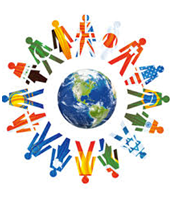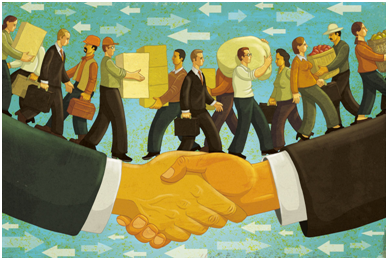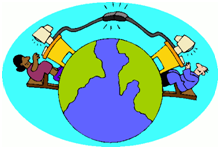What is globalisation?
Globalisation is the ongoing process that is linking people, neighbourhoods, cities, regions and countries much more closely together than they have ever been before. This has resulted in our lives being intertwined with people in all parts of the world via the food we eat, the clothing we wear, the music we listen to, the information we get and the ideas we hold.
- The process of globalisation is driven economically by international financial flows and trade,
- Technologically by information technology and mass media entertainment,
- And very significantly, also by very human means such as cultural exchanges, migration and international tourism. As one commentator remarked, we now live in a networked world.

While globalisation is not a new process, it has accelerated rapidly since World War II, and is having many effects on people, the environment, cultures, national governments, economic development and human well-being in countries around the world.
What drives globalisation?
Economic drivers of globalisation: Free Trade

Since World War II, and especially since the 1980s, governments have reduced many barriers to international trade through international agreements such as the General Agreement on Tariffs and Trade (GATT) and the World Trade Organization (WTO).
These agreements have led to many initiatives to promote what is called “free trade”, including:
- The elimination of tariffs taxes on imported goods
- The elimination of limits on the amount of any product that can be imported.
- The creation of free trade zones where there are only small or no tariffs as well as cheap land and skilled, but controlled, labour.
- The reduction, elimination, or harmonization of subsidies for local businesses so overseas companies can compete against them without any support for local industry and employers.
- The establishment of local subsidies for global corporations so that they can make things cheaper in open country rather than another.
- The harmonization of intellectual property laws and cross-border recognition of intellectual property restrictions (e.g. patents granted by China would be recognised in the United States and vice versa).
These economic and trade reforms are a central part of “free-market economics” which greatly increased opportunities for international trade and investment.
Technological drivers of globalisation: Transport, the media and communications technologies

Technology has been another principal driver of globalisation. Advances in transport and information technology, in particular, have dramatically transformed economic life. Developments in bulk carrier shipping have enabled rapid and cost-effective transport while innovations in logistics and air-transport means that many goods – from African flowers and chocolates to Chinese-made computers and smart phones – can arrive in markets over-night.
However, it is the rapid improvements in information and communication technologies that have provided some of the strongest drivers of globalisation in recent years. The global Internet and its associated capacity for financial transfers have provided companies with valuable new tools for:
- Identifying new and expanded economic opportunities
- Faster and more informed analyses of economic trends around the world
- Easy and instantaneous transfers of payments and profits
- Speedy, often instantaneous, communication and decision-making
- Partnerships with far-flung partners.